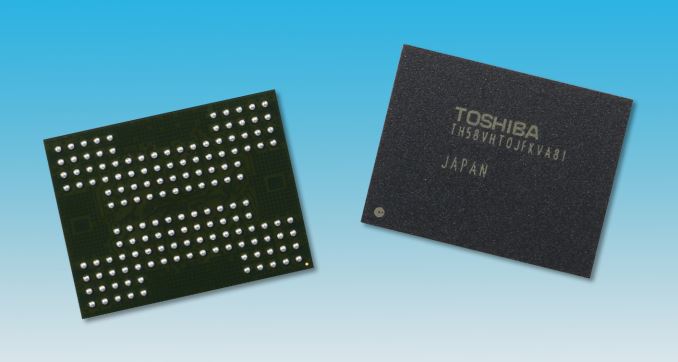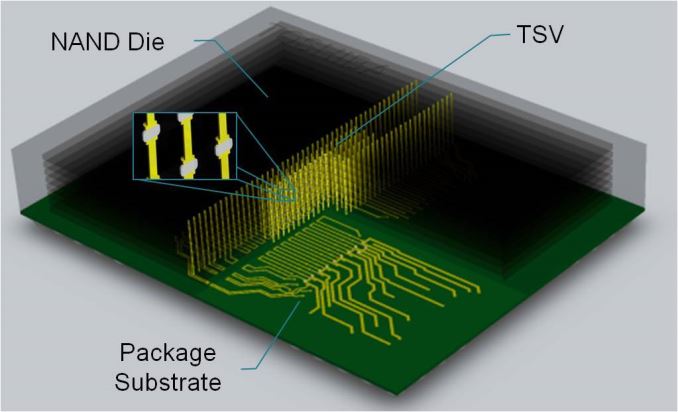Toshiba Brings Through-Silicon Vias to NAND Flash
by Billy Tallis on August 12, 2015 8:01 AM EST
At Flash Memory Summit this week, Toshiba is showing off a NAND flash device packaged using through-silicon vias rather than traditional wire-bonded connections.
The NAND flash currently on the market is typically produced in the form of a die with a capacity like 128Gb (16GB). The popular SSD form factors don't have enough surface area to fit dozens of those chips, and SSD controllers don't have the pin count to connect to that many independently, so several chips are stacked in a single postage-stamp sized package. The traditional way of connecting the individual dies in a stack is to use the same technique as for a single-die package: bonding a thin gold wire between the edge of the die and the package substrate or external pins. The downsides are that it requires a lot of wires and the edges of the dies in the stack need to be exposed somehow, either by staggering them or by putting a spacer between each layer.
An alternative packaging method is to design the dies to participate in the stacking, by including electrical conductors that penetrate the entire thickness of the silicon die so that they can make contact with the dies above and below it in the stack, essentially tunneling right through each die. These through-silicon vias (TSVs) can then form a shared bus to carry signals from any of the dies in the stack out to the last die, which is the only one with the external connections.
Chip stacking using TSVs requires the dies to be aligned and stacked without spacers, which makes the whole stack a bit more compact. Since TSVs can be placed anywhere on the chip rather than just at the edge, it's easy to implement a wide data bus and communication within the stack can be very fast or low-power due to the short distances involved. These advantages have been very attractive for packaging DRAM, most notably in the form of the HBM stacks used by AMD's R9 Fury and R9 Nano video cards.
Toshiba's demonstration is a 16-high stack of 128Gb dies in a BGA-152 package measuring 14mm by 18mm and 1.9mm thick, and an 8-high stack that's 1.35mm thick. Those numbers are all typical even for wire-bonded stacks. The speed (1Gb/s) and operating voltages (1.2V for I/O and 1.8V core) are what we would expect from a next-generation NAND interface, but the claimed 50% power reduction is a very nice improvement for a change that leaves the flash memory cells themselves unmodified.
Toshiba hasn't said whether the dies being stacked are their current 15nm planar NAND or their forthcoming 3D NAND, nor have they said when modules using TSVs will be hitting the market. The most compelling applications would be to use TSVs to stack flash atop a controller chip in an eMMC product or atop an SoC, but the power savings would be appreciated almost everywhere. If the use of TSVs allows economically stacking more than 16 dies, it could enable a dramatic increase in the density of SSDs.












18 Comments
View All Comments
ImSpartacus - Wednesday, August 12, 2015 - link
Neat to see this technique see other uses.Is this a relatively new thing for mass produced stuff? I only recall the term from hbm articles but I wonder if it's been "a thing" for a while.
jjj - Wednesday, August 12, 2015 - link
For high volume (the AMD thing is not really that) Sony has been using TSV in it's stacked image sensors for a while now, Omnivision started this year. Samsung uses TSV in DDR4 . It's not that new (and the concept is rather old) but it's not all that cheap yet either.You won't see it in 10 cents chips soon.DanNeely - Wednesday, August 12, 2015 - link
IIRC it's been used on some SoCs to stack the ram chip on top of the CPU (saving board area) for at least a few years now. What's new is that techniques for stacking large numbers of chips are going mainstream.jjj - Wednesday, August 12, 2015 - link
Don't confuse PoP with TSV.https://en.wikipedia.org/wiki/Package_on_package
menting - Wednesday, August 12, 2015 - link
it's being mass produced now, but there are still some teething issues with things like TSV cracks, misalignment, etc.eanazag - Wednesday, August 12, 2015 - link
I'm tired of the advertising taking over Anandtech.Please let Purch advertising know. I just did with the contact Purch advertising below.
http://purch.com/advertise/#contact-advertising
You can also navigate to this hyperlink with Purch advertising link at the bottom of the website. I'm tired of the ads pushing the Pipeline further down the page everyday, ads taking over my screen (especially on mobile), header ad being larger than the Anandtech header, and etc. I understand that ads pay for the site and I am not against ads. Anand did a great job managing the site in this aspect when he owned it - it lent more credibility to the site. Today there's a notebook review ad for Tom's hardware.
I've been reading since 2007. This is the only site I have a login to comment with. I don't to see this site go to crap. I'm not leaving today, but I can see that be a possibility down the road if this management style continues.
icrf - Wednesday, August 12, 2015 - link
If they don't cover PR drops and trade show reveals, what's left? Just hands-on reviews? This is information of interest to the community, and Anandtech reports on whatever information they have, which is often solely provided by the vendor themselves. Seriously, what's the alternative?MrSpadge - Wednesday, August 12, 2015 - link
Agreed - a quick analysis of a press release is better than nothing, for sure.Mr Perfect - Wednesday, August 12, 2015 - link
I think he means the traditional ads, not the article. If you've got adblock on, turn it off and marvel at how far down the page the actual content has been pushed.Margalus - Wednesday, August 12, 2015 - link
also how narrow the content is. My screen is 22" wide, actual Anandtech content is only contained in an 8" strip down the middle. The other 14" is nothing but advertising. Then you get the pop ups that cover up 50% of the 8" of content, meaning The actual anandtech content is down to about 20" of the screen, the rest is ads...I never used adblockers because websites do need money to run, and they are providing this service without charging me. But this particular website has gotten out of hand and I will be installing an adblocker that will probably only be used on this site. No other website I visit has ads this obnoxious and overwhelming.